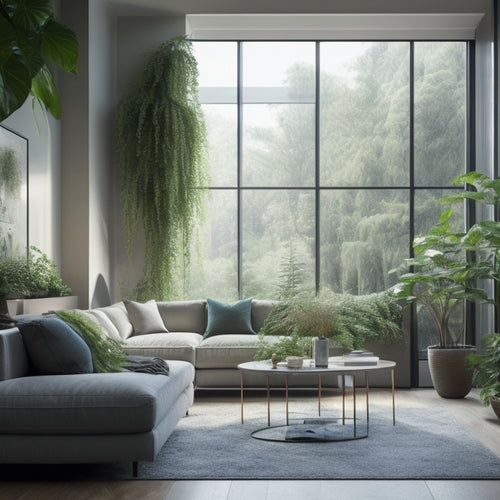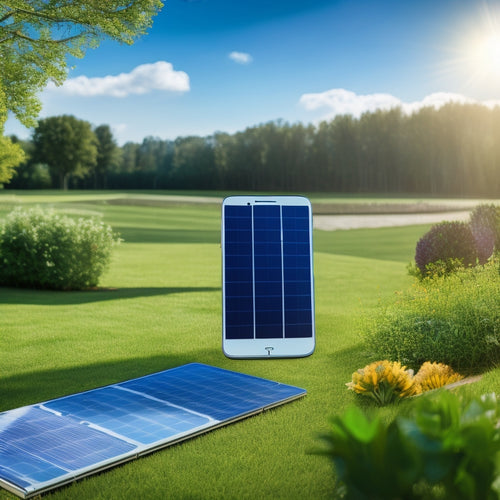
10 Clean Air Hacks for City Home Dwellers
Share
You're likely breathing in polluted air in your city home, with indoor air quality being up to five times more concentrated than outdoor air. To combat this, you can start by purifying the air with houseplants like spider plants and peace lilies, or upgrading to HEPA filters that capture 99.97% of particles as small as 0.3 microns. Sealing air leaks and gaps, installing smart air vents, and incorporating natural ventilation can also make a significant difference. Additionally, eliminating strong chemicals, utilizing essential oils safely, and scheduling regular filter cleaning can further improve your indoor air quality. By implementing these clean air hacks, you'll be taking the first steps towards a healthier living space - and there's still more you can do to optimize your air quality.
Key Takeaways
- Strategically place air-purifying houseplants like spider plants, peace lilies, and snake plants throughout your home to reduce airborne pollutants.
- Upgrade to HEPA filters, which capture 99.97% of particles as small as 0.3 microns, to improve indoor air quality significantly.
- Seal air leaks and gaps in windows, doors, and outlets with caulk, spray foam, or weatherstripping to prevent polluted air from entering.
- Incorporate natural ventilation by opening windows on opposite sides for effective cross ventilation and capturing prevailing winds.
- Eliminate strong chemicals by switching to chemical-free cleaning products and utilizing essential oils safely with aromatic diffusers.
Purify Air With Houseplants
In lively cities, air pollution can be a significant concern, and indoor air quality often suffers as a result.
Regular cleaning and maintenance practices such as daily checks on electrical connections can also contribute to improving air quality by reducing energy consumption and preventing equipment failures.
You can take control of the air you breathe by incorporating air purifying plants into your indoor gardening routine. These plants are natural air filters, removing pollutants and toxins from the air.
Spider plants, peace lilies, and snake plants are all effective at purifying the air. By placing them strategically throughout your home, you can reduce the amount of pollutants in the air.
Indoor gardening is a simple yet effective way to improve air quality and create a healthier living space.
Upgrade to HEPA Filters
You're likely aware that not all air filters are created equal, and when it comes to capturing pollutants, filter quality matters.
Upgrading to a High Efficiency Particulate Air (HEPA) filter can notably purify the air you breathe, removing 99.97% of particles as small as 0.3 microns. By capturing tiny particles, including dust, pollen, and other airborne toxins, a HEPA filter can greatly improve your indoor air quality.
Additionally, with zero tailpipe emissions from electric vehicles, the air quality in cities can be markedly improved, making HEPA filters an even more important investment for city home dwellers.
Filter Quality Matters
Your air purifier's filter quality can make or break its effectiveness in capturing pollutants. A high-quality filter, like a HEPA filter, can capture 99.97% of particles as small as 0.3 microns. This means you'll breathe easier, knowing you're protected from airborne irritants.
In addition, switching to clean energy vehicles reduces emissions and contributes to a cleaner environment, further improving air quality.
However, filter quality also affects filter lifespan and maintenance. A low-quality filter may need to be replaced every few months, while a HEPA filter can last up to a year or more with proper maintenance. Regular cleaning and replacement are essential to guarantee your air purifier continues to perform at its best.
Purify the Air
By opting for a HEPA filter upgrade, city dwellers can greatly enhance their air purifier's performance.
This upgrade is vital in combating indoor pollution, which can exacerbate seasonal allergies and respiratory issues. HEPA filters capture 99.97% of particles as small as 0.3 microns, markedly improving air quality.
As electric vehicles become more widespread, reducing emissions and promoting a cleaner environment, it's important to also focus on indoor air quality.
To maximize the filter's effectiveness, consider pairing it with humidity control, ventilation design, and dust control measures. Regular breathing exercises can also help your body adapt to the improved air quality.
Monitor your air quality with air quality monitors to track the positive impact.
Capture Tiny Particles
As city dwellers, it's vital to recognize the importance of capturing tiny particles, which can aggravate respiratory issues and seasonal allergies.
These microscopic pollutants can easily evade traditional air purifiers, making them a major threat to indoor air quality. With the alarming rate of air pollution and greenhouse gas emissions contributing to climate change, it's necessary to take proactive measures to improve indoor air quality.
Upgrading to HEPA (High Efficiency Particulate Air) filters is a transformative solution for particle trapping. These filters capture 99.97% of particles as small as 0.3 microns, including dust, pollen, and smoke.
Use Activated Carbon Filters
You'll want to contemplate using activated carbon filters to complement your HEPA filters, as they bring their own air purification power to the table.
These filters are particularly effective at removing gases, VOCs, and odors from the air, which can be a significant problem in urban environments.
In fact, reducing fossil fuel dependence solar-powered charging stations can also contribute to cleaner air.
Air Purification Power
Most urban residents spend up to 90% of their time indoors, where air pollutants can be up to five times more concentrated than outdoors.
You need a reliable air purification system to combat indoor air quality issues. Activated carbon filters are a powerful solution, capable of capturing 99.97% of particles as small as 0.3 microns. This includes air pollution sources like dust, smoke, and pollen that exacerbate seasonal allergies.
By controlling humidity and implementing effective ventilation strategies, you can further enhance the filter's performance.
Monitor your air quality with a reliable air quality monitor to guarantee you're meeting air quality standards.
With the right filter and ventilation system, you can breathe easy, enjoying the freedom to live life to the fullest.
Odor Removal Benefits
Nearly every urban dweller has experienced the unpleasantness of lingering odors in their indoor space. You're not alone in this struggle.
Odors can be a significant concern, especially in small, poorly ventilated city apartments. Activated carbon filters can be a breakthrough in your odor removal efforts. These filters use odor neutralization techniques to eliminate unpleasant smells, rather than just masking them with fragrances like scent masking strategies do.
By using activated carbon filters, you can breathe easier knowing that your indoor air is cleaner and fresher. These filters are especially effective against strong odors from pets, smoke, and cooking.
Seal Air Leaks and Gaps
Three common culprits behind poor indoor air quality are gaps and cracks around windows, doors, and electrical outlets, as well as holes for pipes and vents.
These openings allow polluted air to seep in and clean air to escape, compromising your indoor air quality. To combat this, you'll need to draft a thorough weatherization plan.
Start by evaluating the insulation quality in your home, identifying areas where air leaks are most likely to occur. Then, seal these gaps and cracks using caulk, spray foam, or weatherstripping.
Install Smart Air Vents
You can greatly improve indoor air quality by installing smart air vents that optimize airflow and reduce pollutants.
These advanced vents can be integrated with your existing ventilation system to create a more efficient and healthy environment.
Airflow Optimization Tips
How can you maximize airflow in your urban abode? By implementing effective airflow strategies, you can breathe easier and reduce indoor air pollution.
To optimize airflow, focus on duct maintenance. Here are 4 key tips:
-
Seal duct leaks: Make certain all connections are airtight to prevent heated or cooled air from escaping.
-
Clean ducts regularly: Remove dust and debris to improve airflow and reduce allergen circulation.
-
Upgrade to high-velocity ducts: Increase airflow by up to 50% with high-velocity ducts designed for urban homes.
- Use zoning systems: Control airflow to specific areas of your home to reduce energy waste and improve overall airflow efficiency.
Ventilation System Upgrades
Air quality control systems in urban homes often overlook an essential component: smart air vents.
You can upgrade your ventilation system by installing these intelligent vents, which optimize airflow and improve indoor air quality. By automating ventilation efficiency, smart air vents reduce energy consumption and minimize the strain on your HVAC system.
They can detect pollutants and adjust airflow accordingly, ensuring a healthier breathing environment. Additionally, smart air vents can be integrated with air purifiers and sensors to create a thorough air quality management system.
Rotate Ceiling Fans Correctly
One simple trick to enhance indoor air quality is to rotate ceiling fans correctly.
You're probably thinking, "What's the big deal about fan direction?" Well, it's essential for energy efficiency and air circulation.
During summer, run your ceiling fan in a counterclockwise direction to push cool air down, making your space feel cooler. In winter, switch to a clockwise direction to circulate warm air trapped near the ceiling.
Here are some key considerations for ideal fan rotation:
- Summer mode: Counterclockwise direction to push cool air down.
- Winter mode: Clockwise direction to circulate warm air.
- Adjust fan speed: Match the speed to your heating or cooling system's output.
- Reverse direction seasonally: Switch fan direction with the changing seasons.
Incorporate Natural Ventilation
City dwellers often overlook a simple yet effective way to improve indoor air quality: incorporating natural ventilation into their daily routine.
By opening windows on opposite sides of your home, you can utilize cross ventilation benefits, allowing fresh air to circulate and stale air to escape.
Strategic window placement is key, so consider installing windows on multiple sides of your home to maximize airflow.
You'll also want to position them to capture prevailing winds, which can help push pollutants out of your living space.
Eliminate Strong Chemicals
Clear out harsh chemicals from your cleaning arsenal to give your indoor air quality a significant enhancement.
By switching to chemical-free cleaning products, you'll reduce indoor pollution and create a healthier living space. Investigate non-toxic alternatives, eco-friendly products, and homemade cleaners that employ natural fragrances and biodegradable materials.
- Choose products with safe storage instructions to prevent accidental exposure.
- Opt for concentrated formulas to reduce packaging waste.
- Select products with clear, transparent labeling to guarantee you know what you're bringing into your home.
- Consider DIY cleaning solutions using common household items to minimize waste and cost.
Utilize Essential Oils Safely
With essential oils gaining popularity as natural air fresheners, it's crucial to understand how to use them safely to avoid compromising your indoor air quality. You can enjoy the health benefits of essential oils, such as mood enhancement and allergy relief, while maintaining good air quality. To do this, use aromatic diffusers, which release natural fragrances without heating the oils. This prevents harmful chemicals from being released into the air.
| Safe Applications | Benefits |
|---|---|
| Diffusion for air purification | Eliminates pollutants, freshens air |
| Topical use for skin issues | Relieves skin irritations, promotes healing |
| Natural cleaning agents | Replaces harsh chemicals, eco-friendly |
When selecting essential oil blends, consider your scent preferences and the specific health benefits you're looking for. Always choose high-quality oils and follow the manufacturer's instructions for safe use.
Schedule Regular Filter Cleaning
Behind the scenes of your air purification systems, filters work tirelessly to remove pollutants and allergens from the air.
They're your unsung heroes, but they can't do their job effectively if they're clogged with dirt and debris.
That's why you need a filter maintenance routine to keep them in top shape. Create a cleaning schedule to guarantee your filters are cleaned every 1-3 months, depending on usage and manufacturer instructions.
Here are some key tasks to include in your schedule:
- Check your filter's condition monthly to determine if it needs cleaning.
- Vacuum or brush off loose dust and dirt from the filter surface.
- Wash the filter with mild soap and warm water, if recommended by the manufacturer.
- Allow the filter to dry completely before reinstalling it in your air purifier.
Frequently Asked Questions
Can I Use Air Purifiers in Small, Enclosed Spaces Like Closets?
You're likely aware that 90% of our time is spent indoors, where pollutants can be 2-5 times higher than outdoors. Yes, you can use air purifiers in small, enclosed spaces like closets, but guarantee good closet ventilation to maintain effective air quality.
How Often Should I Water My Air-Purifying Houseplants?
You'll want to water your air-purifying houseplants when the top inch of soil feels dry, ensuring ideal humidity levels between 40-60%. Overwatering can lead to root rot, so monitor moisture and adjust your plant watering schedule accordingly.
Are HEPA Filters Effective Against Gases and Odors Too?
You might think HEPA filters only capture particles, but don't worry, they're also effective against gases and odors; in fact, they can remove up to 99.97% of gases, VOCs, and odors, providing you with a safer, fresher breathing space.
Can I Use Essential Oils in My Air Purifier or Humidifier?
You're wondering if you can use essential oils in your air purifier or humidifier, which can be a great alternative to diffusers, but first, consider the essential oil benefits and potential drawbacks, ensuring safe and effective integration.
Will Sealing Air Leaks Increase My Energy Bills?
You'll actually reduce your energy bills by sealing air leaks, as it enhances energy efficiency and promotes cost savings by minimizing heat loss and optimizing HVAC system performance.
Related Posts
-

7 Best Automated Sprinklers for Water-Wise Green Homes
You're likely among the 75% of U.S. homeowners who use in-ground sprinkler systems, and coincidentally, you're also c...
-

Why Vertical Gardens Reduce Home Energy Consumption
By incorporating a vertical garden into your home design, you'll reduce energy consumption through natural insulation...
-

7 Best Solar Panel Upkeep Apps for Homeowners
You can optimize your solar panel's energy output and efficiency by up to 20% with regular maintenance, which is wher...


